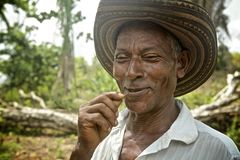
According to the Program of Land Protection, 5.4 million hectares—an area larger than Switzerland—were abandoned as a result of the violence just between 1998 and 2010. Photo: Sean Hawkey/ACT
María Ligia Chavera is a 72-year-old Afro-Colombian woman who has struggled the last 14 years to recover her land in the Chocó. She was displaced in 1997 along with her community of Curbaradó. “We walked suffering, passing up work, eating without salt, washing without soap, sleeping in the mountains, literally lying on top of snakes,”[1] she tells, remembering those years of forced displacement. Theft from displacement victims is one of the gravest scourges in Colombia.[2] According to the Program of Land Protection, 5.4 million hectares—an area larger than Switzerland—were abandoned as a result of the violence just between 1998 and 2010.[3] According to Marco Romero, director of the Consultancy for Human Rights and Displacement (CODHES), in many cases “[C]oercion was used to buy lots at low prices and people were forced to sign away deeds.”[4]
In the face of this situation, the Government of Juan Manuel Santos has proposed an initiative for land restitution to victims that is currently making its way through the Colombian Congress as a unified law.[5] The proposal seeks to create mechanisms and strategies for the handover of land to the displaced population.[6] The return of two million hectares of land to those from whom it was stolen—about 250.000 hectares per year—is one of the principal pieces to begin what the Government considers integrated reparation for the victims of the violence.[7]
The challenges of the proposed law
The proposal has garnered widespread support among the parties of the Government coalition. However, although some civil society organisations believe that “the victim and restitution law is a fundamental contribution because it recognises, from the Government, that this plundering does exist,”[8] organisations like the National Movement of Victims of State Crimes (MOVICE) have certain reservations, to the point of rejecting the proposed law.[9]
For Jorge Luis Garay, director of the Commission of Public Policy for Displacement Monitoring,[10] the proposed law is filled with challenges and obstacles that will take a long time to be worked out.[11] Iván Cepeda, Representative in Colombia’s Lower House of Congress with the Alternative Democratic Pole (PDA) party and member of MOVICE, fears that the proposal will not have the hoped for results. The principal problem he identifies is that reparation depends upon fiscal stability: “The Government has presented a concept of reparation that is subject to certain criteria, like fiscal stability, that could make it totally inefficient.”[12]
In addition, the proposed law posits the restitution of two million hectares of land, but according to the calculations of the Center for Research and Popular Education (CINEP), there are 6.5 million hectares of plundered land.[13]
Many other questions remain: “How will a displaced population be able to sustain itself on a plot of returned land without support for income generation, and without public roads, sewers, electricity and security conditions? For this reason, it is important to integrate into the debate in Colombia the Principles for the Return of Housing and Wealth of Displaced Refugees and Displaced Persons.”[14]
The Santos Government’s plan of action
Until April of this year, the Santos Government had in place an action plan that proposed the hand-over of land to 138,000 peasant families in the departments of Magdalena, Bolívar, North Santander, Chocó, Tolima, Antioquia, Cesar, Arauca, Meta and Putumayo.[15] As of January 2011 the Colombian Rural Development Institute (INCODER) had handed over 121,000 hectares to 38,000 peasants under the direction of the Agriculture and Rural Development Ministry.[16]
Protecting social leaders
On a farm known as “Germany” (La Alemania) in the municipality of San Onofre (Sucre), 15 people have been murdered for their work to reclaim these 550 hectares of property.[17] The latest victim was Rogelio Martínez, a 48 year-old member of the Sucre chapter of MOVICE, who was killed in May 2010.[18] During 2010, in Urabá alone, nine peasants who were leading projects to recover stolen land were murdered.[19] In all of Colombia, 40 human rights defenders and representatives of displaced communities were murdered in 2010, 33 since President Juan Manuel Santos took office and Congress began debating the Victims and Land Restitution Law. This has occurred in at least nine departments, including Córdoba, Antioquia, Chocó, Sucre, Cauca, Valle del Cauca and the regions of Magdalena Medio and Catatumbo.[20] According to the internet site about paramilitaries and armed conflict in Colombia, Verdad Abierta, “the paramilitary figureheads have attempted at all costs to impede the return of stolen land to displaced peasants.” The site also says: “The methods that are used […] to intimidate and prevent the victims from demanding what belongs to them are the same used before the paramilitary demobilisation: accuse the leaders of being guerrilla leaders, attempt to intimidate them and in the end murder them in order to stop the return of the stolen land.”[21]
Threats continue against organisations that reclaim their land, and there has also been an increase in the theft of sensitive information about these groups.[22] Cristian Salazar, director of the United Nations High Commissioner for Human Rights in Colombia, has stated, “The protection of victims who reclaim land, as well as their organisations, should have the same priority as restitution itself, because above all the State is responsible for protecting life.”[23] And that, according to Garay, is “where the poison is.”[24]
The amount of plundered or abandoned land
A study by the Commission of Public Policy for Displacement Monitoring demonstrates that 90% of the displaced population has lost its land. “The amount of hectares of land usurped or abandoned because of violence between 1980 and July 2010 is almost 6.65 million, without counting territory held collectively by ethnic communities. This amount of land is equal to 12.9% of arable land in the country. According the investigation, 1998 and 2008 was the period in which the greatest amount of land was usurped or abandoned: 5.3 million hectares.”[25]
[1] Interview with PBI, November 2010.
[2] “Victims Law: Commitment to Truth, Justice and Reparation,” Congreso Visible, 11 November 2010, see: www.congresovisible.org/agora/post/ley-de-victimas-compromiso-de-verdad-justicia-y-reparacion/437/
[3] “The project of the Victim’s law approved in the House has unconstitutional characteristics.” La Silla Vacia, 8 January 2011; see: www.lasillavacia.com/historia/el-proyecto-de-ley-de-victimas-aprobado-en-la-camara-tiene-rasgos-de-inconstitucionalidad-2.
[4] “Access to land has been the focus of the armed conflict,” Semana, 25 November 2010.
[5] “The proposals of President Santos: Hope for the victims?,” CINEP, November 2010.
[6] “The 11 actions of the government to restore land to those from whom it was plundered,” CINEP, November 2010.
[7] “Restitution of land will be retroactive 15 years,” El Tiempo, 12 October 2010; see: www.eltiempo.com/justicia/ARTICULO-WEB-NEW_NOTA_INTERIOR-8127782.html.
[8] “Access to land has been the focus of the armed conflict,” Semana, 25 November 2010.
[9] “Discussion document about the current proposed victim’s law,” MOVICE, 13 December 2010; see: www.movimientodevictimas.org/index.php.
[10] The Commission is composed of Consultancy for Human Rights and Displacement (CODHES), the Long Live Citizenship Corporation, the Faculty of Law of the University of Los Andes, and different people like the ex Defender of the People and ex President of the Constitutional court, Eduardo Cifuentes, the journalist Patricia Lara and the national director of the Social Ministry of the Colombian Catholic Church Monseñor Héctor Fabio Henao.
[11] “The proposed Victim’s Law approved in the House has unconstitutional aspects,” La Silla Vacía, 8 January 2011; see: www.lasillavacia.com/historia/el-proyecto-de-ley-de-victimas-aprobado-en-la-camara-tiene-rasgos-de-inconstitucionalidad-2
[12] “If errors are not corrected, the Victims Reparation Law will be inefficient,” Agencia Prensa Rural, 13 November 2010, see; www.prensarural.org/spip/spip.php.
[13] “The proposals of President Santos: Hope for the victims?”, CINEP, November 2010.
[14] “Land, territory and forced displacement,” United Nations Development Program, 2010; see: hechosdelcallejon.pnudcolombia.org/hechos_57/Tierras_territorios_
desplazamiento.pdf.
[15] “History of a crusade,” Semana, 15 January 2011; see: www.semana.com/noticias-nacion/historia-cruzada/150193.aspx.
[16] Ibid, 15.
[17] “The farm in Sucre that has cost the life of 12 people for trying to reclaim it,” El Tiempo, 2 May 2010; “The long list of victims of “Germany” hamlet in San Onofre,” New Rainbow Corporation, 18 May 2010.
[18] “Member of MOVICE murdered for reclaiming farm,” PBI Colombia, September 2010.
[19] “Óscar Maussa, another leader of the displaced, is murdered,” Verdad Abierta, 26 November 2010; see: www.verdadabierta.com/conflicto-hoy/rearmadados/2885-oscar-maussa-otro-lider-de-despojados-de-uraba-asesinado.
[20] Ibid. 17
[21] “Death persues those who reclaim their land,” Verdad Abierta, 23 May 2010; see: www.verdadabierta.com/nunca-mas/38-desplazados/2483-la-muerte-persigue-a-los-que-reclaman-sus-tierras.
[22] “Threats against NGOs and peasants who reclaim their land denounced,” El Colombiano, 12 JAnuary 2011; see: www.elmundo.es/elmundo/2011/01/21/solidaridad/1295601602.html.
[23] “Displaced leader murdered in Bolívar was stoned and tortured,” El Tiempo, 23 January 2011; see: m.eltiempo.com/justicia/gobierno-pide-investigar-asesinato-de-lder-de-desplazados-en-urab/8457920
[24] “The proposed Victim’s Law approved in the House has unconstitutional aspects,” La Silla Vacía, 8 January 2011; see: www.lasillavacia.com/historia/el-proyecto-de-ley-de-victimas-aprobado-en-la-camara-tiene-rasgos-de-inconstitucionalidad-2
[25] “National Verification Survey of the rights of the displaced population,” Public Policy for Forced Displacement Monitoring Commission, in “What size is the plunder of land and property in Colombia?, Semana, 19 October 2010.
